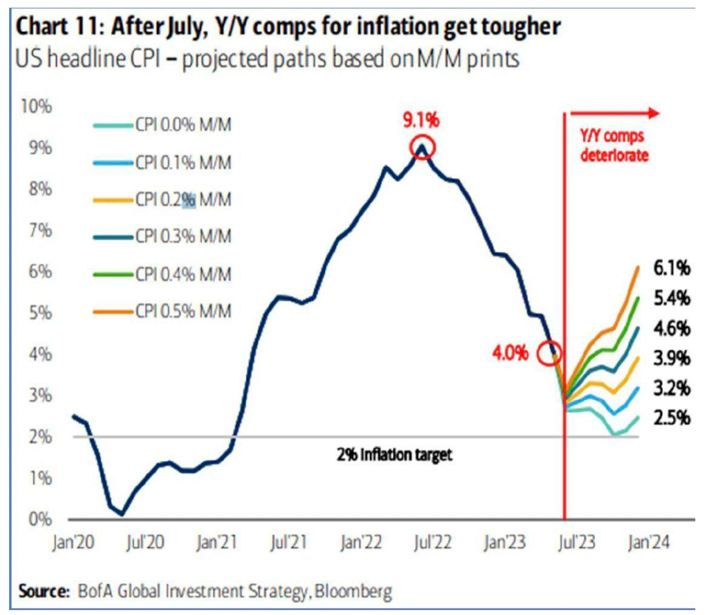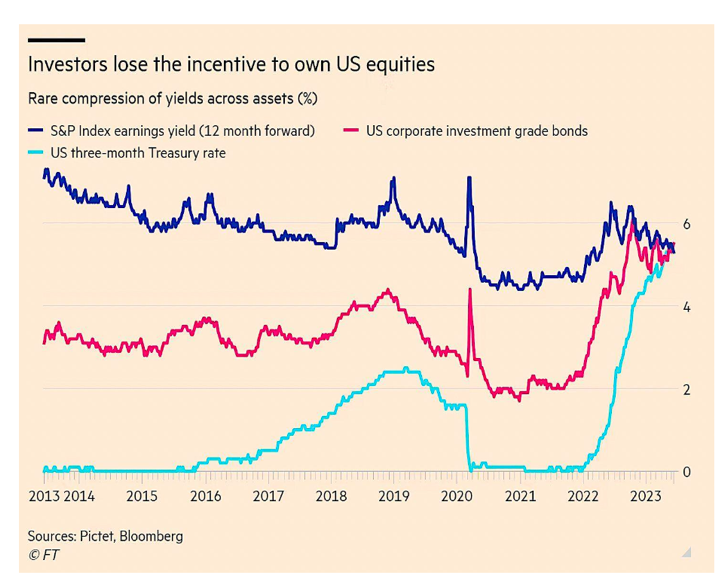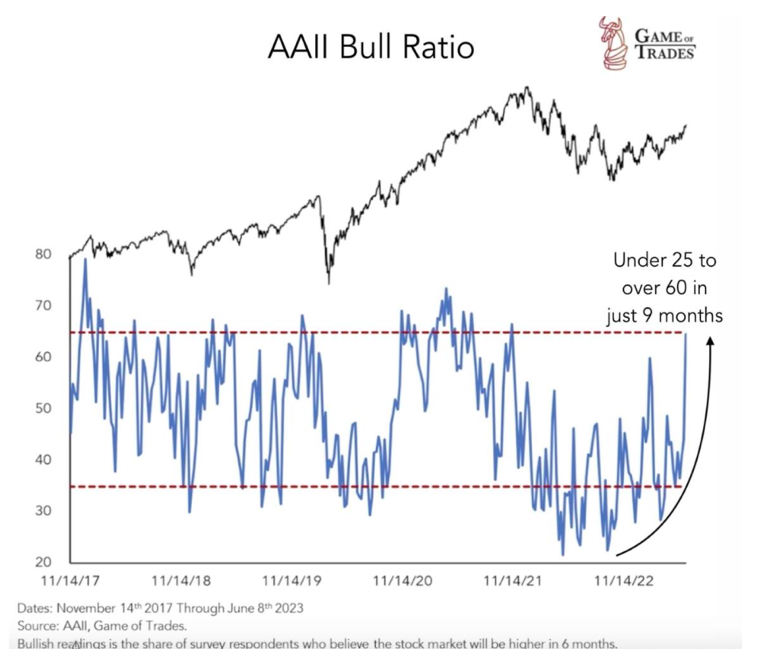Postcards from the florida republic: An independent and profitable state of mind.
With weakening momentum in the market, we head into the final week of the first half of 2023.
Markets have rebounded from the lows of October and December 2022 – aided by remarkable central banking aid and expanded economic conditions.
As we put a fork in the first half, let’s reflect on a few key charts and explain their importance today…
Then we’ll discuss why the music will stop for equities soon…
One Narrative Bests Another One
We had one negative momentum event in the first half of 2023 – down from three in the first half of 2022. Bank of America noted this week that the unexpected event of the first six months was “Artificial Intelligence” and not Silicon Valley Bank.
I’d argue something lateral – largely the result of central bank policy and how it helps fuel risk-off behavior after short-term crises. This year, venture capital collapsed, and higher rates crushed Big Tech’s competition. But the Fed backstopped the financial system in March. I explained last week in Postcards.
Bank of America cited 1998 and the collapse of Long-Term Capital Management as a catalyst for a new cyclical growth theme: the Internet. The Fed eased, and more liquidity entered the system.
Once again… liquidity is what matters most. It’s just a question of when the music will stop playing. Just seven stocks pulled this market from 3,800 to nearly 4,400. And the combination of $11 trillion of passive investment (money locked in ETFs) and the constant barrage of ODTE options (options expiring within the next 24 hours) continues to offer support in Big Tech names.
We don’t see funds dump large amounts of equities unless forced, and ODTE options will be here to stay, given the amount of money involved (and the lack of interest from regulators on the subject. So, what do we need to watch as the second half starts…
The Market’s Next Threat
One thing I’ve learned after 25 years of financial study is that the next threat to the equity market is yesterday’s BIG problem.
There’s a lot of focus on commercial real estate. We have renewed chatter about stability in the banking sectors. And there’s also the new chatter about a power vacuum in Russia.
But when Wall Street media finally realize that this market and its cycles are Groundhog Day, everyone will sober up from the recent rally and see that the threat remains inflation.
The Fed has said it will likely raise interest rates at least twice more in this cycle, but the markets don’t want to believe Powell. I’ve said this multiple times over the last 18 months. The Fed is not bluffing. People who write “the Fed is bluffing” are the people who are bluffing. They’re begging you to buy overpriced equities from them so they can take more profits.
One must understand the looming threat and how to properly measure it over the last two years. To see what the Fed sees.
Look at the eye-popping numbers of inflation that happened during the first half of 2022. When we measure year-over-year inflation, the numbers from May and June look tame. The problem starts when we look out toward the end of the year when we see September 2022 inflation measures compared to September 2023.

The year-over-year figures could be much higher from here. This is one reason we expect the Fed to raise rates at least twice (if not more).
Bank of America lists a variety of possible outcomes depending on month-over-month prices starting in July. Check it out.
While there’s a baseline for inflation to hit the Fed’s target later this year before rebounding, there’s also the chance that monthly upticks slingshot us higher yet again into the start of 2024 – all while inflationary odds remain at “damn certain” levels for next year. It’s a wide spread of possibles.

What does this do in H2 2023?
As I previously explained, higher rates will push the yields of corporate and Treasury bills higher. The S&P 500 earnings yield could weaken – on the backside of the year.
Incentives to own stocks right now aren’t very high. But the prospect of a good earnings season (despite consistent downward revisions) exists…
Let’s dig into why inflation might drive margins higher in Q3.
On Consumer Profits – And H2 2023
Inflation has one more element to consider for H2 2023. Right now, we’re listening to politicians suggest that grocery stores and gas stations are prompting inflation. They just ignore that these businesses have notoriously low historical margins.
As Dr. Peter St. Onge noted this week, three issues have driven corporate profits in 2023 with one central theme. Inflation…
First, too much money chased too few goods… in the wake of Covid shutdowns (it’s not companies that shut themselves down). Anyone arguing that increasing the money supply by 35% didn’t increase inflation must re-read everything Milton Friedman wrote.
Second, we must consider how accounting properly reflects inflation on a balance sheet. When supply chain prices increase, the nominal final sale numbers increase. But companies aren’t “healthier.” A one- or two-time accounting measure points profit margin higher because inventory was cheaper. In essence, it's not permanent margin expansion. But we’ll likely see another quarter or two of this phenomenon. We’ll revisit in a moment…
The third reason for profit margin expansion is the growing uncertainty. Companies don’t invest in expanding business when concerns about recession or consumer weakness emerge. Hard stop.
So, their margins temporarily expand when companies stop spending money but keep selling products at these newly higher prices (see Part I and Part II). They look very profitable…
But again… this is not sustainable. Future growth is pressured.
We could have two more quarters of stronger nominal earnings that lull this market into a false sense of complacency. As St. Onge explains, we may see “profits rise into the storm….”
And then, as false security emerges, the bottom falls out.
Or the way we prefer to describe it… The Music Stops Playing.
Interestingly… this is the most bullish that the markets have been since November 2021. That was the month that I was on air with Kenny Glick predicting the ensuing bear market of 2022.

In just nine months, the AAII Bull Ratio went from deeply bearish (25 reading) to the highly bullish level of 65.
My general expectation is that we’ll see more tightening into the second half of the year, one more gasp on strong corporate profits, and then a large decline in consumer spending as we head into the fourth quarter when retail REALLY needs a lot of support.
We’re NOT even out of Act I of the Federal Reserve’s policy cycle – “How High.” After we reach a terminal rate, Act II will center on “How Long” the Fed keeps rates up. That will be a never-ending fever dream of wild speculations around Fed speeches and knee-jerk reactions from AI-driven reading prompts.
And then, in Act III, the U.S. economy should be taking enough of a body blow that corporate profits may bottom. At that point, look for executives to buy up stocks. Please don’t rule out more inflation fighting over the years ahead… as the Green transition (particularly the metals) cost an arm and leg due to supply-and-demand imbalances, all while we kneecap the oil-and-gas sector.
Keep Dancing, But Get Closer to the Door, Please
As I note, we bring everything down to one number with momentum. When momentum is Green, we’re buying stocks. We’re largely getting out of the way and hedging when it's red.
This week is historically positive for the strongest components of the S&P 500 and negative for mid-cap stocks thanks to a rotation from weaker names. But past performance does not guarantee future returns.
The music will play until it stops. It looks like there could be a day-ending red signal soon. (Yellow on Friday). We already know funds have been heading for the exits since Quad Witching.
The Week in Review
- Mom, That UN Guy Is at the Front Door, Ranting About Oil Companies Again
- The amount of Metals Coming Out of the Ground Will Be Seismic And Big Money for Your Portfolio
- The Smartest Move I Ever Made in the Oil Markets Was Walking Out on These Two Guys…
- Everyone Now an Expert on Russia... Everyone.
- This Isn't Old Macdonald’s Farm ... E-I... "A.I"... Oh!
- The Blue-Collar AI Potential
- One Last Stealth AI Stock... and Then I'll Leave You Alone
- Fear and Loathing on the I-95 Corridor
- Six Rules for Negative Momentum
- Momentum Is Likely Heading Red Soon (What to Do Now)
 To your wealth,
To your wealth,
Garrett Baldwin
Florida Republic Capital (Available on Substack)
About the Author
Garrett Baldwin is a globally recognized research economist, financial writer, consultant, and political risk analyst with decades of trading experience and degrees in economics, cybersecurity, and business from Johns Hopkins, Purdue, Indiana University, and Northwestern.



